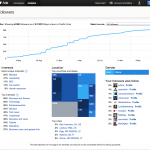 That companies will both monitor what is said online, and have the capability to rapidly act upon what they read remains something of a nirvana. A lot of the time this is a combination of under resourcing your social monitoring function, and not equipping those people with the ability to act on the things they observe.
That companies will both monitor what is said online, and have the capability to rapidly act upon what they read remains something of a nirvana. A lot of the time this is a combination of under resourcing your social monitoring function, and not equipping those people with the ability to act on the things they observe.
That isn’t to say that all that social data should go to waste though. A new study looks at utilising it for analytics purposes rather than sales. The study looked in particular at the pizza industry. They looked at the social activity of Pizza Hut, Domino’s and Papa John’s and collected quantitative data from the three chains, including number of followers and number of posts made. They also mined the posts made on each of the companies Facebook pages.
They found that the companies were using social media very differently on both Facebook and Twitter. On Twitter for instance, some 31% of tweets were related to orders, with another 28% discussing quality and taste of the pizzas. Another 40% were used to promote deals and offers.
Facebook on the other hand tended be more active for each of the three companies. The community facilities offered by the platform proved particularly popular, whilst of course Papa John’s has integrated e-commerce directly into its Facebook page, thus allowing fans to buy direct from the site.
What is noticeable however is that investing in social does pay off. Domino’s have invested in resources for their social effort, with dedicated staff members assigned to engage with staff members. This is reflected in their output online, with a higher number of posts on both Facebook and Twitter than the other two chains. They also managed to respond to comments more quickly than either of the other companies.
As the amount of social data increases, so to do the number of tools on the market to help collect and analyse that data, ranging from commercial tools such as SAS Enterprise Miner to free tools such as Hootsuite. Taken together, these programs enable companies to track real-time social media dialogue and traffic, create graphical reports, and organize the data by keywords or even user sentiments.
The authors conclude by suggesting that companies wishing to embark on this journey establish clear benchmarks against which they can compare progress as their project progresses. What’s more, if you can compare not just your own performance but that of your rivals then it gives your work that all important context that will allow you to really establish how well you’re doing.